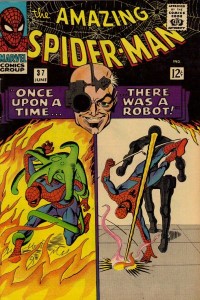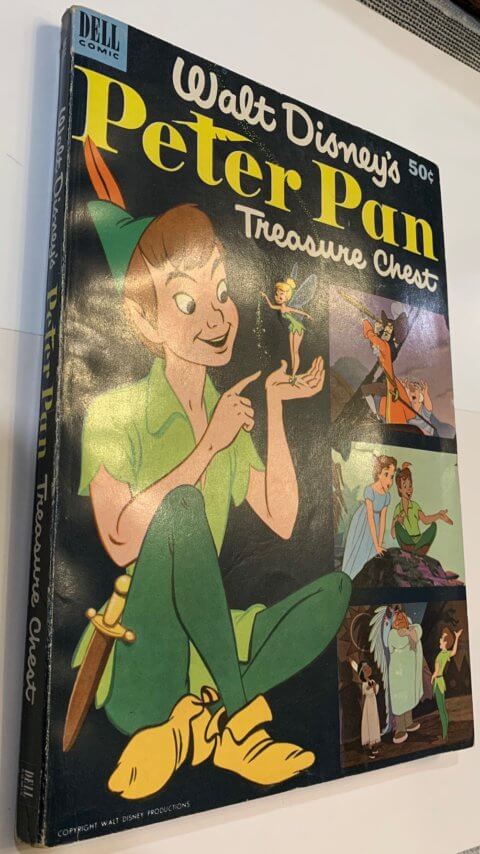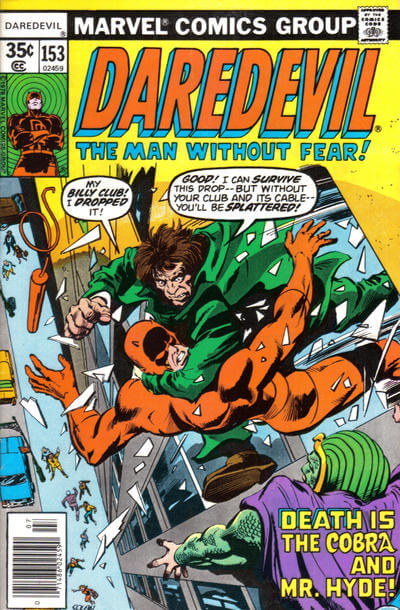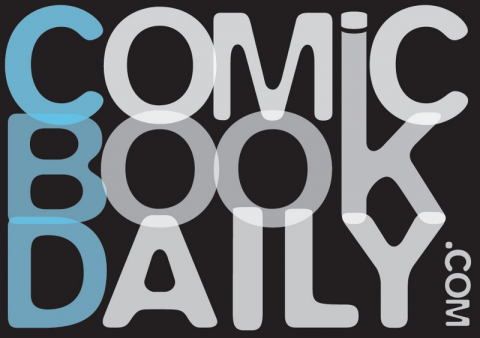 Amazing Spider-Man #37, Marvel Comics, June 1966
Amazing Spider-Man #37, Marvel Comics, June 1966
Recently I’ve been receiving some strong Spotlight suggestions from Juan from Rochester N.Y. These are good solid picks he’s sending in, I’m lucky he doesn’t want to start up a website.
According to Juan it’s about time we flush out Amazing Spider-Man #37 from the #32-38 grouping in the guide. I have to agree with him.
Amazing Spider-Man #37 introduces Norman Osborn who in two short issues later (in Amazing Spider-Man #39) will be revealed as the Green Goblin.
So why doesn’t Norman Osborn’s introduction carry more weight than the Looter’s 1st appearance (#36), Mary Jane Watson’s 2nd appearance (#38 – face not shown!) or Kraven’s 4th appearance (#34)? Huh? Why?
Well it should.
Today Norman Osborn is a big player in the Marvel U. He was used prominently in Civil War and Secret Invasion and will continue to be one of Marvel’s baddest of the bad. You could even argue that Norman Osborn has in ways eclipsed his Green Goblin persona. As I’ve said the character is one of the biggest movers and shakers in the Marvel U. So if Osborn is as big as the Goblin…
Look for Chris Cooper playing Osborn in this summer’s Amazing Spider-Man #2 movie and look for more demand for Amazing Spider-Man #37 if Cooper delivers a great performance.
Honestly, you’d be hard pressed to think of a comic with a more myth and folklore surrounding it.
The Green Goblin is seen by many as Spidey’s greatest villain. The Goblin 1st appeared in Amazing Spider-Man #14; he was an instant smash hit and appeared again in issues #17, 23, 26 and 27.
In the Goblin’s first 5 appearances his secret ID was famously kept from comic fans leading to a lot of excitement and speculation as to who it would turn out to be.
This leads us to one of the biggest urban myths of the Silver Age: that Steve Ditko quit Amazing Spider-Man and Marvel because he and Stan Lee disagreed over the secret identity of the Green Goblin.
I’ve spent the last hour reading way too many interview quotes on the subject. I’ve come away believing that Ditko did have Osborn in mind but I can understand the controversy surrounding the events of that time period.
Neither Steve Ditko nor Stan Lee ever told us the full story of why they split. Stan Lee has always claimed he was never told, Steve Ditko has always said he was never asked. It is easy to see how speculation could start as to why Ditko left.
Since I know very little I’m the perfect candidate to speculate. By 1966 Stan was solidifying his Marvel Way of doing things. Steve Ditko was in personal flux at the time immersing himself into Ayn Rand’s Objectivism. The two obviously had creative differences and the fact that the Green Goblin’s ID was revealed in the issue right after Ditko left only fueled the myth for the reason for the split.
John Romita Senior was given the title after Ditko left. Romita had just come off his first work on Spidey in Daredevil #16 (May 1966); was that a tryout?
For most Amazing Spider-Man #37 appears to be the set up issue for #39. Was this Stan winning the arguments?
Who can say on these things: the principals aren’t talking and we may never know the full story but boy is it fun to speculate. Today we are sitting in a world where Spider-Man is firmly in the top 3 of the hero heap. Who know what would have been if things had played out differently.
I did some digging at market prices and census figures for Amazing Spider-Man in issues the #34 to #38 range. Surprisingly I found very little fluctuation in price and the number of CGC copies available in the 9.0 to 9.4 grades.
You can pick up a solid CGC 9.2 for less than $600.
The 43rd edition of the Overstreet Comic Book Price Guide shows $147/$324/$500 as the 8.0/9.0/9.2 price split.
Strengths that make this comic book a good long-term investment are:
- Introduction Norman Osborn
- The myth that Lee and Ditko argued over whether Osborn should be the Goblin
- Nice black cover looks great in higher grades




Good call Juan from Rochester N.Y. and Walter. This book does deserve more recognition than it has received.
There is precedent for a book breaking out of this run, and that is the previously undervalued Amazing Spider-Man #31 that used to be lumped in with #32-38. This change occured somewhere between the Overstreet Price guide #31 and #35. Maybe some keen CBD reader can tell us exactly when this change took place.There is a $300 price difference in between ASM #31 and the others in NM today.
I guess we may never know know why Steve Ditko left Marvel. I think it turned out to be the best thing that ever happened to Spider-Man. Ditko was OK, but I think he had taken the character as far as he could, and the change was much needed. IMO John Romita’s work defined the character, and as you say Walt who knows what would have happended if the change didn’t occur.
As for Norman Osborn being the Green Goblin, I can tell you this revelation was met with a bit of surprise and to some dismay at the time ASM #39 came out. Some picked Osborn. I was betting on Fredwick Foswell. Others were picking another unknown villian from a different title ( Like a Red Skull), Ned Leeds, or others.
Norman Osborn died for me in Amazing Spider-Man #122.
Thanks, Walter – awesome post! Love to be able to contribute to this fantastic site. It is not far fetched to regard ASM # 37 as the single most key issue in the Ditko run. Consider how Iron Man # 55 has sky rocketed as a result of Thanos – – No disrespect to the the big guy, but Osborn is as key if not more so, yet, this issue lags. Moreover, this is a Silver Age comic, part of the Lee/Ditko run – it should be in higher regard than Iron Man # 55. I know, I know – it’s what the market will bare, sure. But, the market has under the radar gems, hence, the purpose of this site. This comic will clear through a grand sooner than later.
Above I stated “what the market will bare.” It should read – what the market will bear. However, come to think of it – bare works also – as in exposed. Nevertheless, the correct phrase includes bear. Now I’ve bared myself as a bit on the neurotic side – sure.
I’ve always had relative trouble selling lower and mid grade copies of this book over the years. The book would sell out of the bins but always for below guide. All the focus was placed on #39. A lot of old collectors bought off the Guide, if the guide said a book was special then they wanted it, if the book was buried in a long grouping under one price then they didn’t want it as much.
Mike made the comment above that #31 used to be in the #31-38 grouping and how has been given distinction. I’ll bet #37 will follow.
It’s a spot on observation. The Guide needs to signal out this issue, the first Norman Osborn on a seperate line and a price that reflects this distinction should follow.
Although Norman Osborn has always been a top villain/character among Spidey fans, his widespread MU recognition and appeal is a relatively recent development. If we take the Spider-Man history into account – one could argue that Osborn’s introduction ranks as the single most significant intro of a character in the entire Lee/Ditko run of Amazing Spider-Man. Keep in mind, Aunt May and Uncle Ben are Amazing Fantasy intros. Sure, we have Jonah, Gwen and Harry introduced before Norman Osborn, but none of those characters have evolved into widespread MU significance.
I’ll also add that issue 37 presents a wonderful, more mature effort by Ditko. I know many have elevated Ditko to godlike status, but I’ve always found his work to be barely palatable. It’s not until issue 31 that his pencils become solid, pleasing to the eye.
It seems odd that certain Bronze Age villain intro receive more of a demand than Osborn’s intro. I already mentioned Thanos. But Sabertooth is another one that has unjustified demand.
Clearly, I’m a bit bias, but …
“It is not far fetched to regard ASM # 37 as the single most key issue in the Ditko run”
Wow. Sorry, but that IS incredibly far-fetched. Despite what Walt says, despite Marvel wanting to make Osborn another Lex Luthor/Kingpin type character, Osborn is and always will be primarily important because he is the Green Goblin, the guy who killed Gwen Stacy, the guy who first discovered Peter Parker’s secret identity (yes, not *technically* the first, but…yeah).
And the GOBLIN’s 1st appearance was long before this issue — and also happened to be a part of the Ditko run (along with the 1st appearances of Dr. Octopus, Vulture, Sandman, and *virtually* every other major Spidey villain, ever, except for Venom and maybe one or two others).
Look, I own a nice copy of this issue, so I’m all for the idea that its value should increase, but come on, let’s not overstate the case. I agree it’s undervalued relative to some others, and that this is a more important comic than the 1st Thanos, but among “important early ASM issues” it’s got AT LEAST a dozen issues ahead of it.
Walt, I’m interested in what leads you to believe Ditko “did have Osborn in mind”. Maybe I’ve missed something, but everything I’ve ever read suggests otherwise: Lee wanted a dramatic revelation, and Ditko wanted a “more realistic”, less coincidental surprise, with a nonentity to be revealed as the Goblin. (Does every villain need to have some personal connection to Peter Parker? How small is the Marvel Universe, anyhow?) This fits with Ditko’s philosophy; he also infamously wanted to have a major character killed in a car accident or some mundane, non-super-hero manner, but Lee thought that wasn’t dramatic enough for a fictional hero’s storyline. It’s also compelling, if rather circumstantial, that the Goblin’s identity wasn’t revealed until the issue AFTER Ditko left.
If one chooses to remain in 1972, then, yes – then Osborn is ONLY the Green Goblin the maniac who killed Gwen. Sure.
BUT, this is not 1972 – in fact, much has transpired. Osborn, like it or not, is a major player in the MU. He’s NOT just the maniac who killed Gwen – he’s become more than just the Green Goblin.
AND, sure – the Goblin’s first appearance was in # 14. But, guess what? A character becomes a character, a true character, a compelling character – when he/she has a face, a story. The true Green Goblin was born the moment Osborn was introduced and selected to be the Goblin. Don’t kid yourself on this – trust me.
NOW, to my point – issue 37 provides the single most significant INTRODUCTION of a character. I stand by this. As you paraded a few words, you failed to point out which introduction trumps Norman Osborn’s.
Again, this is not 1972. Norman Osborn is not just the Green Goblin. He is not just the maniac that killed Gwen. In fact, I would argue that Osborn was not a significant villain until he killed Gwen. Through his murder of Gwen and his own demise he became larger than he ever was before. Consider this – the Goblin reared his green head only ONCE on the pages of Amazing – between Romita’s debut and Conway’s execution of the character. His only appearance was in issues 96 – 97 (yea, I know – he appeared in the magazine, Spectacular).
SO, the Norman Osborn that IS a major player in the MU is a recent development. But it is clear that Osborn IS a major player who’s influence goes well beyond the pages of Spider-Man.
‘Nuff said!
I meant issues 96 – 98. To be clear – Osborn’s appearances were limited: Lee/Romita unmask the Goblin in 39, knock him out in 40. Then, the magazine story. Goblin pops in for issues 96 – 98 – then comes back to kill Gwen.
The Goblin became the Goblin, the true Goblin via Norman’s introduction. The Goblin/Osborn is popularized in fandom as a result of the death issues 121/122.
Thor!
I read quite a bit while looking into this, probably visited a dozen sites.
There was one site that quoted a Ditko interview for The Comics I think where he hints that he planted the son of the Goblin in a school issue (I’m assuming its #31) complete with similar hair styles.
The tone of the statement led me to believe he was saying it was Osborn. I will look for that article, I’m sure that’s what he said in it – unless I misinterpreted it.
To further the case: In 2009, Norman Osborn, not the Goblin, was ranked as IGN’s 13th Greatest Comic Book Villain of All Time.
Amazing Spider-Man # 37 may be among the top ten most important comic books of the Silver Age.
Oh, IGN said that? OK, case closed!
Sorry, I’d have to still disagree, or at least reiterate that you’re overstating the case. *Especially* on your contention about the “true” debut of the Goblin as a compelling character.
Very early on, the Goblin became the most popular of Spider-Man’s foes in large part BECAUSE his identity, unlike all the other villains’, was secret. Fans were kept in suspense. (Same with the Hobgoblin in the ’80s). You’re right that the revelation of his identity added another layer and retroactively made #14 and the other appearances more important, but I see that as more a means of KEEPING him popular once the “captial” of the secret identity was “spent” in the payoff of #39-40 (and this is why, IF that was the source of the Lee/Ditko disagreement, in terms of drama and ongoing storylines Lee was probably right).
And… “not a significant villain until he killed Gwen.” ??? Surely that’s hyperbole. Yes, obviously the death issues elevated his status as a villain to new heights (depths?) than ever before, but he was already the top Spider-Man villain…that is *precisely* the reason they CHOSE HIM as the one to kill her. Likewise:
– chosen as the villain for Romita’s debut issues
– chosen as the 1st to unmask Peter (sure, Dr. Octopus did so in #12, but that was quickly explained away and had no lasting impact);
– chosen as the villain of the full-colour Spectacular magazine
– chosen as the villain of the high-profile “drug issues”
You’re right, he wasn’t used very often…because he knew Spider-Man’s identity and could destroy him at any moment! This was referenced many times in the years that followed, and was a new source of tension once the Goblin’s secret identity was no longer a factor. Lee didn’t “write him out” of the series through the late ’60s because he was insignificant — if anything, I see it more as a case of Lee “picking his high spots”. (By comparison, Dr. Octopus, probably the only Spidey villain to challenge for top spot, wasn’t used all that often in that period, either. I don’t have any figures but I can think of only a handful of appearances between #53 and #113 — maybe just a few more than Goblin).
Again, I do agree that #37 is undervalued somewhat. I just don’t agree that it’s a more significant issue than #14, #3, or #1, nor, for that matter, the first Romita issues in which the secret is revealed, #39-40. But if the value of #37 even approaches any of these in the collector market, I’ll admit defeat in this. Don’t hold your breath though. For 50 years ASM#37 has never been considered even in the top 10 of ASM issues, much less of the whole Silver Age…I don’t expect to see that changing, no matter how passionately you argue the case.
I guess I just value the weight of history over whatever Marvel’s current flavour-of-the-month storyline is (Chris Cooper and movie sequels notwithstanding). I never said Osborn was “only” the Green Goblin. How long before the current MU is exploded and recreated with another spate of #1 issues, anyway? I guess this is the point at which I most disagree with you and Walt: Current comics and movie hype just don’t change the value of really old comics THAT much. Robert Downey, Jr can do a dozen blockbuster Avengers and Iron Man movies, but TOS#39 will NEVER be worth more than AF#15 …even if the next ten Spider-Man movies suck worse than Spider-Man 3.
^ I meant “capital”
A lot of good debate and points being made here. I’d like to add a few more.
1. Having lived through the original Green Goblin/Norman Osborn age I can tell you flat out the Green Goblin was considered Spider-Man’s #1 villian by most of the fan base, mostly for the reasons pointed out by Odinson. Doc Ock would be #2 on my list followed by the Kingpin.
2. The Green Goblin/Norman Osborn character was in 5 issues prior to issue #37 and 15 after. Norman Osborn played a pivitol role in issue #47. He was in issues #61-66 regaining his memory leading up to Spectacular Spider-Man #2 magazine, plus the others listed by Juan. That’s 20 appearences in 122 issues – pretty significant. I have a lot of relatives I don’t see that much.
I don’t know as much about modern books as I should, so the next couple of points are questions that anyone can feel free to answer.
1. If Norman Osborn is such a big deal now and by all accounts he is – why is the book he is ressurrected in (24 years later) Peter Parker Spider-Man #75 only a run book worth $4? Captain America was only gone for about 10 years and his re-introduction was a big deal then and today.
2. Are there other characters in the MU that have had new found success in the modern age that have influenced prices in the silver or bronze age?
Juan – I like your passion for this book. I like the book too, but not to the same extent. You aren’t sitting a bunch of 9.2’s on this one are you ^-^!
Mike – to your point on Osborn’s appearances – YES! Osborn appearances, not Goblin appearances. The Goblin appearances were limited to the issues I stated. This point you bring up validates my initial point on the matter.
As far as PPS-M # 75 – WELL, this is easy! Clearly another UNDERVALUED SPOTLIGHT candidate!
Odin – we are not in disagreement (sorta, kinda). It seems we’re just not communicating at a proper level. Here is my attempt at clarification: You agree it is undervalued. Good. You want #1, # 3, # 14 to stay in higher regard. OK. I agree # 39 & 40 should be higher, but these are not Ditko issues – my argument is regarding the Ditko run. So, back to # 1, 3, and 14. My focus on elevating # 37 above these three issues is based on INTRO of a character. Osborn, you and others have agreed, is Spider-Man top foe. Sure, the Goblin is introduced in 14, but the man becomes know in 37. Even if I agree that 14 trumps 37, why do 1 and 3 trump 37? Otto is not above Norman. And issue 1 is truly significant, but not unique – there are two (one on the way) other # ones. BUT, even if I surrender to all your submission – 1, 3, and 14 (Ditko era), we still have # 37 as an issue that should significantly stand out above the rest of the run – and, as of now – it is not. Are we now at a quasi-agreement?
Oh, and NEWSarama ranks Norman Osborn as the fifth most significant villain in the MU. Now, don’t go hating NEWSarama and IGN – they are qualified sources. They are not law, but they do represent widespread sentiment (sometimes).
By the way, Dock Ock had a hell of a run between 53 and 159. He appeared in 14 issues. In contrast – the Goblin appeared in a mere 7 issues between 39 and 122. I’m not saying Otto trumps the Goblin, but if I did – the numbers back me up.
Gotta add more – even during the Ditko era, Ock made more appearances. Between issue 3 (Ock’s intro) and issue 38 (Ditko’s last), Ock appeared in SIX issues. The Goblin, between issue 14 (Gobby’s intro) and 38 appeared in FOUR issues. No matter how you slice it, how you dice – Dock Ocks appeared more often than Gobby. The Goblin became a major character as a result of the Norman Osborn persona introduced in issue # 37.
Look, all this is a matter of opinion – true. But, no one here has posted a logical argument that can show the Goblin to be a more significant villain (compared to Ock) until he was revealed as Norman Osborn. The Goblin’s claim to fame comes down to the drug issues (96, 97, 98) and the death issues (121, 122). His appearances were limited. Dock Ock trumps the Goblin in appearances during the Ditko era. Ock pounds the Goblin in appearances in the post Ditko era leading up to issue 159. By the way, 159 is the cut off point because up till then Amazing (not including Team Up and Giant Size, etc) was the only continuity. PPSM began at about Amazing’s 161.
The introduction of Norman Osborn propelled the Goblin ( a villain that may have faded away) into prominence. As mentioned by Mike, Osborn (NOT the Goblin) made various appearances. It was Osborn that elevated the character. OSBORN IS THE CHARACTER!
So, it is clear, ever so clear, that the introduction of Norman Osborn was the most significant introduction of the Lee/Ditko era (not including May and Ben; and if we give Jonah an edge, fine).
Juan – Please let me clarify something. This is a from a Silver/Bronze age view. Norman Osborn appearences have never raised the value of a single comic book (yet). He doesn’t even rate a mention in Overstreet for his appearences in issue #61-66. It may not be fair but it is a fact. My question above on PPS-M # 75 related to the fact the character isn’t increasing value (yet) in the modern age either.
Green Goblin appearences raise the value of every comic he appears in whether it is Norman or Harry Osborn in the costume. The only exceptions are Spectacular Spider-Man Magazine #2 and Spider-Man Annual #9 (see Undervalued spotlight #145 – plug, plug,).
In a nostalgia driven hobby it is the Green Goblin we love. The Norman Osborn version is the one we seem to love best.
Mike – read everything I’ve posted carefully.
The bottom line is this – by the way, you opened by agreeing with me that issue 37 is undervalued – the bottom line is that ASM # 37 is undervalued. How undervalued? I have no idea. But we agree it is undervalued.
Thor – like, Mike, embedded in your narrative there is agreement that ASM # 37 is undervalued.
We are in agreement. It is undervalued.